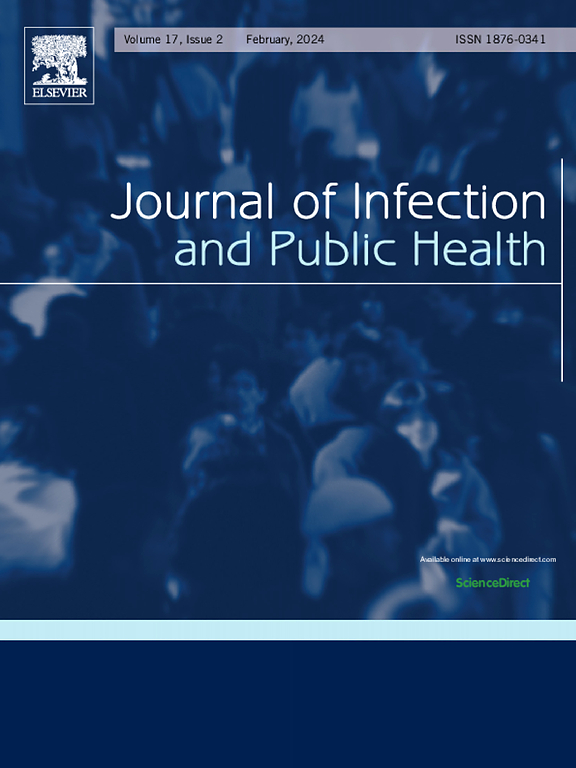2022-2023年图巴大Magal期间呼吸道和胃肠道病原体的环境表面采样
IF 4.7
3区 医学
Q1 INFECTIOUS DISEASES
引用次数: 0
摘要
众所周知,图巴大Magal (GMT)朝圣与感染风险有关,但尚未对微生物污染环境的作用进行研究。材料和方法我们在2022-2023 GMT期间对朝圣者和他们居住的房屋的表面进行了采样。采用qPCR检测呼吸道和胃肠道病原菌。结果采集的152个表面中,肺炎链球菌阳性率为10.5 %,金黄色葡萄球菌阳性率为5.9 %,SARS-CoV-2阳性率为16.4 %,肺炎克雷伯菌阳性率为3.9 %,鼻病毒阳性率为0.6 %。在所有检测的胃肠道病原体中,只有大肠杆菌阳性,其中肠致病性大肠杆菌(EPEC)(23.7% %)和肠聚集性大肠杆菌(EAEC)(22.4% %)最为常见。在接受检测的71名朝圣者中,66.2% %感染了呼吸道病原体,包括16.9% %的嗜血杆菌,7.0 %的SARS-CoV-2, 11.3 %的肺炎链球菌,5.6 %的金黄色葡萄球菌,1.4 %的鼻病毒和2.8 %的流感病毒。另外23.9 %感染了胃肠道病原体,包括EAEC(18.3 %)、EPEC(2.8 %)、贾第鞭毛虫(5.6 %)和EIEC/志贺氏菌(2.8 %)。结论初步结果表明,表面采样结果与人感染SARS-CoV-2和EAEC有良好的相关性。在格林尼治标准时间期间,SARS-CoV-2表面采样可作为监测工具。需要进一步的大规模研究来证实这些初步发现。本文章由计算机程序翻译,如有差异,请以英文原文为准。
Environmental surface sampling of respiratory and gastrointestinal pathogens during the 2022–2023 Grand Magal of Touba
Background
The Grand Magal of Touba (GMT) pilgrimage is known to be associated with risks of infection, but no studies on the role microbial contamination of the environment has been conducted yet.
Materials and methods
We sampled pilgrims and surfaces in the houses where they were accommodated during the 2022–2023 GMT. Respiratory and gastrointestinal pathogens were tested by qPCR.
Results
Of the 152 surfaces sampled, 10.5 % tested positive for Streptococcus pneumoniae, 5.9 % for Staphylococcus aureus, 16.4 % for SARS-CoV-2 (Severe acute respiratory syndrome Coronavirus 2), 3.9 % for Klebsiella pneumoniae, and 0.6 % for rhinovirus. Only Escherichia coli was positive out of all the gastrointestinal pathogens tested, with enteropathogenic E. coli (EPEC) (23.7 %), and enteroaggregative E. coli (EAEC) (22.4 %) being the most frequent. Of 71 pilgrims tested, 66.2 % acquired a respiratory pathogen, including 16.9 % Haemophilus spp., 7.0 % SARS-CoV-2, 11.3 % Streptococcus pneumoniae, 5.6 % Staphylococcus aureus, 1.4 % rhinovirus, and 2.8 % influenza virus. A further 23.9 % acquired a gastrointestinal pathogen, including EAEC (18.3 %), EPEC (2.8 %), Giardia lamblia (5.6 %) and EIEC/Shigella (2.8 %).
Conclusion
These preliminary results showed a good correlation between results of surface sampling and human infection for SARS-CoV-2 and EAEC. SARS-CoV-2 surface sampling could be used as a surveillance tool during the GMT. Further larger-scale studies are needed to confirm these preliminary findings.
求助全文
通过发布文献求助,成功后即可免费获取论文全文。
去求助
来源期刊

Journal of Infection and Public Health
PUBLIC, ENVIRONMENTAL & OCCUPATIONAL HEALTH -INFECTIOUS DISEASES
CiteScore
13.10
自引率
1.50%
发文量
203
审稿时长
96 days
期刊介绍:
The Journal of Infection and Public Health, first official journal of the Saudi Arabian Ministry of National Guard Health Affairs, King Saud Bin Abdulaziz University for Health Sciences and the Saudi Association for Public Health, aims to be the foremost scientific, peer-reviewed journal encompassing infection prevention and control, microbiology, infectious diseases, public health and the application of healthcare epidemiology to the evaluation of health outcomes. The point of view of the journal is that infection and public health are closely intertwined and that advances in one area will have positive consequences on the other.
The journal will be useful to all health professionals who are partners in the management of patients with communicable diseases, keeping them up to date. The journal is proud to have an international and diverse editorial board that will assist and facilitate the publication of articles that reflect a global view on infection control and public health, as well as emphasizing our focus on supporting the needs of public health practitioners.
It is our aim to improve healthcare by reducing risk of infection and related adverse outcomes by critical review, selection, and dissemination of new and relevant information in the field of infection control, public health and infectious diseases in all healthcare settings and the community.
 求助内容:
求助内容: 应助结果提醒方式:
应助结果提醒方式:


